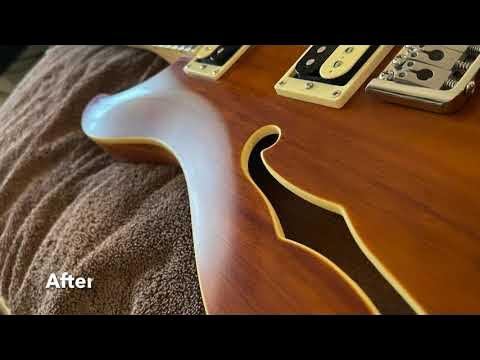Imagine caressing your fingers over a guitar that feels nearly as smooth and warm as actual skin; a guitar with an understated elegance that sings a charming, sonorous melody. That’s the profound intimacy I felt the first time I ran my hands over a satin finish acoustic guitar. It was the beginning of a deep fascination and love for this extraordinary instrument—let’s just say it struck a chord in my heart in a way that I hadn’t expected.
But, the affair between a guitarist and a satin finish guitar doesn’t just stem from its sensual appeal; there’s more hidden beneath the surface. As a two-decade veteran in designing and constructing stringed instruments, I’ve uncovered the radical differences of these satin beauties compared to their glossy counterparts, and how their unique characteristics influence the overall sound and playing quality.
Contrary to popular practices, a satin finish isn’t always the go-to choice for everyone. It comes with its own suite of benefits and possible disadvantages. But trust me, once you’ve tasted the charms of a satin finish guitar, you might find it hard to settle for anything less. After all, isn’t music, in essence, an affair of the heart and fingers?
Taking this journey together, we’ll delve into the intriguing world of satin finish guitars, explore why they might be the perfect choice for you, and how to care for them to keep the melody alive. So, all you music enthusiasts and guitar aficionados, are you ready to strum along? Let’s uncover what makes the satin finish guitar sing its unique song.
What a Satin Finish Guitar Is

Before we plunge into the alluring world of the satin finish guitar, let’s ponder a bit. Picture your favourite acoustic performance. Got it? Now, let’s examine whether the finish of the guitar had an essential part to play in that. Could the enticingly rustic look of a satin finish guitar have contributed subtly to your mesmerising experience? It’s certainly a possibility, and here’s why.
In my early years of lutherie, I was intrigued by the aesthetic of the satin finish and how it could affect the overall sound of the instrument. Its unique charm nestled intriguingly between the rustic guitar look and an indulgent elegance. This journey of understanding turned into a lifelong intrigue as I engaged deeper with the craft and the intricate world of guitar aesthetics. It’s rustic yet refined, and I cannot wait to dive deeper into this with you.
But first, what exactly is a satin finish guitar? Simply put, it’s a type of guitar finish that sits between the glossy and matte spectrum. Reflecting less light than its glossy counterpart, while still retaining a bit of sheen compared to a matte finish, a satin finish guitar is often celebrated for its understated charm and organic vibe. The result? A subtly soothing visual effect that often complements the inherent beauties of the wood grain.
This fine balance also enhances the tonal characteristics of the guitar, making it a coveted choice among professional musicians and enthusiasts alike. The satin finish is achieved through several stages of fine sanding and buffing, a precise and labour-intensive process that lends the guitar its distinctive and appealing texture. As a result, the guitar aesthetics are not only enhanced but also preserved.
Further, there’s a delightful tactility to satin finishes that is refreshingly different from the typical high gloss finishes you might have encountered. To touch such a guitar is to engage with a smooth, warm surface, creating a sense of intimate connection between the musician and the instrument. This unique tactile experience, to me, is the satin finish’s irresistible allure.
In essence, the satin finish is an intriguing blend of aesthetic pleasure, tonal enhancement, and tactile delight, contributing to an enriching guitar-playing experience. In the next section, we will delve into the compelling reasons one should choose a satin finish guitar and its delightful perks. This exploration of the satin finish is essential to truly appreciate its contribution to your unique music journey.
So, let’s proceed, understanding that the satin finish, with its unique blend of rustic charm and refined elegance, truly shapes the aesthetics, sound, and feel of the guitar. Its influence on your acoustic experiences is profound, a factor that may even seem surprising but is undeniably significant.
Why Choose a Satin Finish
Advantages of Satin Finish

Moving beyond surface-level aesthetics, why should you choose a satin finish for your guitar? From personal experience, it’s the practical benefits that truly set satin apart.
From a constructor’s perspective, the relative ease of application of the satin finish is its first merit. This feature ensures that the charm and texture of the wood grains are preserved and highlighted. However, the advantages continue in the hands of the musician themselves.
The satin finish boasts impressive fingerprint resistance. This is a trait especially appreciated by those frequently performing on stage or in well-lit areas. No one enjoys the aesthetic displeasure of smudged fingerprints illuminating under stage lights. Here, satin emerges with its understated elegance and practicality, with its soft, mellow sheen refracting light evenly for a reliably beautiful glow.
The feel and touch of satin contribute largely to the playing comfort too. I’ve found that the smooth yet slightly granulated finish of satin under fingertips can make the difference in the execution of my performance. It sits perfectly in the sweet spot between the sheer hard gloss and the rough open pores finishes, blending the best of both worlds. It’s something I consider incredibly important for those long hours in the studio or on stage.
So, when you’re considering a satin finish, remember it’s not just a matter of aesthetics. It plays a pivotal role in enhancing playing comfort and maintaining your guitar’s new-out-of-the-box look with its excellent fingerprint resistance. This is the hallmark of guitars that visualize and sound just as harmonious as they are played.
Possible Disadvantages of Satin Finish

In choosing a satin finish for your guitar, it would be remiss of me not to draw your attention to a few potential drawbacks, primarily revolving around the durability of the finish. As I have personally experienced, satin finish may wear over time, faster than its gloss counterparts could. The soft, muted look of the satin finish, though appealing to many, is prone to showing signs of wear more readily.
Finish durability is a significant factor to consider. While satin finishes often possess a tangible texture that many players find invaluable, this very same quality could turn out to be its bane. The absence of a resilient outer layer means that the finish could, over time, become susceptible to damage from interaction with elements in its environment – dings, pick scratches and even sweat could eventually dull and discolour the satin surface.
Moreover, the satin finish wearing isn’t an evenly distributed process. What often happens is that the areas of the guitar where your arm or hand commonly rests start to shine before other areas which see less contact. This can result in your once uniformly finished satin guitar sporting a mixed, inconsistent look over time.
The aforementioned doesn’t necessarily make satin finishes a less worthy option, but these risks are something to bear in mind. Keep in mind that a satin finish guitar requires certain care practices to maintain its appearance. In our subsequent section, we’ll look at contrasting satin finish with other finishes to give you a comprehensive understanding of what each finish type brings to the table.
How Satin Finish Differs From Others

In my years of working with a variety of guitar finishes – from the sheen of gloss to the sleek subtlety of matte – I’ve been deeply fascinated by how they contribute not just to a guitar’s visual appeal, but also its tonal characteristics. When it comes to satin finish guitars, this curiosity has led me to guess upon a unique state of affairs, one that distinguishes satin from all others.
But, before we delve into those intricacies, let’s step back a bit. Did you know that the finish of your guitar could impact how its sound matures over the years? Shocking as it may sound, this fact underscores the importance of understanding how each finish type affects your instrument.
For starters, satin vs gloss guitars. Gloss finishes, with their sophisticated shine, provide a high level of protection. But, it comes with the caveat of reducing the guitar’s resonance due to its thickness, leading to less dynamic sound development over time. Satin finishes, however, create less of a barrier between the player and the woods, resulting in a more responsive, organic, and evolving tone.
Among other popular guitar finishes, there is the matte finish, a close cousin to satin. While they both lack the gleam of gloss, matte absorbs rather than slightly reflects light, giving your guitar a very soft and non-reflective exterior. This minimalism of a matte finish offers more wood breathe compared to a gloss finish, similar to satin but with a different tactile experience.
When considering the nitro finish, it is worth noting how its thin layer enhances the guitar’s tone by allowing the wood to vibrate more freely. However, it lacks durability and requires a more cautious approach to prevent wearing down or damage. In contrast, the satin finish is a middle ground, providing both tone-friendly characteristics and a durable layer for the guitar.
In the broad landscape of finishes, there’s also a place for guitars with natural guitar finish and polyester guitar finish. Natural finishes celebrate the raw beauty and resonance of the wood, while polyester ones stand up to the rigors of long-term usage and maintain brightness. Satin finishes subtly embody facets of both—the natural warmth of wood, balanced with resilience, minus the high sheen of polyester.
In the grand finish comparison, the satin finish stands as an intriguing middle path, providing a cocktail of protection, aesthetics, and tonal evolution. As we’ve seen through these comparisons, while each finish has its unique selling points, satin continues to carve its niche within this rich tapestry – offering guitarists an elusive balance of benefits that cater to diverse preferences and needs.
So, as we continue exploring the world of satin finish guitars, remember that the finish you choose can shape your guitar-playing journey in surprising ways. In the next sections, we will look at where to find a satin finish guitar that fits your bill, how to choose one wisely, and maintain its longevity without compromising its distinctive charm.
Where to Find and How to Choose a Satin Finish Guitar

Let’s delve into the glimmering world of satin finish guitars, which often pose a challenge for even the proficient guitarists among us when it comes to selection and purchase. This is where my experience of years jumps in, coming with a wealth of insights and practical nuances to make this process smoother for you!
It’s not uncommon to find oneself overwhelmed by the dazzlingly varied choices in the guitar market. However, the real trick lies in locating the right satin finish guitar that resonates with your specific needs. Having sourced numerous satin finish guitars over the years, I’m well-placed to guide you through this labyrinth.
Looking for a hassle-free experience while buying your satin finish guitar? This might be your roadmap. To start, most reputable guitar stores will have a selection of satin finish guitars. Alternatively, numerous online platforms like Sweetwater, Guitar Center and Musicians Friend offer detailed specifications and high-resolution images to ensure you feel confident about your purchase.
The key aspect to focus on while purchasing a satin finish guitar is exactly what its name suggests- the finish. An ideal satin finish should be smooth and soft, devoid of any glossiness. While high-gloss guitars are popular for their shine, satin finish guitars charm enthusiasts with their underplayed elegance.
However, remember that guitar glossiness isn’t a static factor and can change over time, resulting in a satin finish becoming glossy. This is more prevalent in areas that come into frequent contact during play, like the neck and body contours. While some find this evolution fascinating and a testament to the guitar’s journey, others prefer the initial subtlety of the satin sheen.
Consider a few important factors before you settle on a guitar. Assess the playability by checking the setup, the action (distance between the strings and the fretboard), and the neck’s feel. Also, sound plays a vital role. Try out each guitar if possible and choose the one whose tonal character resonates with you the best. And, don’t forget to take into account the tone woods, the quality of hardware, and compatibility with your playing style.
Depending on your preferences, remember that the satin finish can and will vary across manufacturers and guitar models. For an optimal balance between a matte aesthetic and exceptional sound, I recommend brands like Gibson, Fender, and PRS, known for their satin finish variants.
So, whether you’re a budding guitarist hunting for your first instrument or an established one looking to add a satin finish guitar to your collection, my key advice is to stay patient, explore options, and never rush this process. With the right knowledge and understanding, finding your dream satin finish guitar will be a rewarding journey.
When and How to Maintain a Satin Finish Guitar

As a luthier, caring for instruments forms the heart of my profession, and I’ve found that a satin finish guitar demands some exclusive care practices. While a glossy guitar finish may be familiar territory for most, dealing with satin finish care is a slightly off-beat path. This is because, unlike a gloss finish, a satin one gets shinier the more you play it, owing much to the oils from your hands. However, this shouldn’t deter you from owning this beauty – the solution lies in proper maintenance.
So, when is the right time to maintain your satin finish guitar? The answer is not as straightforward as you may think. Unlike its glossy counterparts, a satin finish guitar doesn’t necessarily require rigid schedule-based maintenance. Yet, a good rule of thumb to follow is to clean your guitar after every concert or prolonged playing session. Look out for signs like oil accumulation or discoloration. These are your cues to roll up your sleeves, whip out your cleaning supplies, and get to work.
Concerned about the life of your satin finish guitar? Let me share some secrets from my 20 years of experience. The first one being, with satin finish care, less is more. This might sound counter-intuitive, but excessive cleaning could damage the guitar’s natural patina. So, keep the cleaning minimal and focus more on preventive measures. A dry, soft, lint-free cloth is your best friend. Lightly wiping down your guitar after a play can assist in reducing oil build-up significantly.
Now, let’s talk about some vital guitar cleaning tips specific to satin finish. Firstly, avoid using guitar polish or any other liquid-based cleaning agents. These products often leave residues that build up over time, changing the unique texture of the satin finish. Instead, opt for a slightly damp cloth for the body and a specialized fretboard cleaner for the neck. Remember, a moderate approach is essential when it comes to maintaining the unique charm of your satin finish guitar.
Occasionally, you might come across minor scratches or scuffs that threaten to mar the beauty of your guitar. However, before opting for a guitar finish repair, understand that minor imperfections are often part of the satin guitar’s inherent character. Unless the damage is excessively severe or impacts the functioning of the guitar, let the little reminiscences of your playing history remain.
What if the finish starts looking too shiny for your liking? Don’t fret. A light hand sanding using ultra-fine sandpaper can restore the matte look. But remember, this should be done carefully and sparingly to avoid patches.
I often get asked if applying clear coat over satin finish is a viable option. While it might seem a straightforward solution to maintain the look, I always discourage this. Adding a clear coat changes the guitar’s tonal properties and, indeed, impacts the very reason why you chose a satin finish in the first place.
As you navigate your journey with your satin finish guitar, remember the charm of this unique finish is its organic transformation with time. Through mindful maintenance and by following these tips, you can ensure the longevity of your guitar while preserving the distinct character of its satin finish.
FAQs
What is a Satin Finish Guitar?
How does a Satin Finish Guitar compare to others?
How do you care for a Satin Finish Guitar?
Conclusion
As we circle back to explore the threads of this narrative, it is evident that guitar finishing techniques, particularly the satin finish, are woven deeply into the fabric of guitar craftsmanship. Not just preferred for their aesthetic appeal, satin finish types offer very tangible benefits to both the player and the instrument.
Is your perception of your guitar changing as we near the end of this journey? Have the subtle complexities of the satin finish begun to resonate with you, much like the way your favorite chord beautifully reverberates through its soundbox? This nuanced understanding of your instrument is perhaps the most enriching takeaway from this exploration.
Casting back our thoughts to the potential drawbacks of satin finish, indeed, there can be challenges. A lack of robustness compared to other finishes is notable, as is its increased vulnerability to wear. But these are small hurdles to overcome, and can be effectively managed with the right care regimen.
Selecting the right satin finish guitar and caring for it effectively is an art form, a process that should be informed by understanding the unique properties of this type of guitar finishing technique. One must be knowledgeable in when and how to maintain their instrument and the signs to look out for. This is not about just prolonging its life, but also ensuring that the instrument remains a delight to play.
As we wrap up, I want to summarize all my thoughts and experiences working with satin finish. I can assure you, this journey of exploration was far from the vicinity of the drab technicalities often associated with it. The satin finish, in its nuanced complexities, opened up vast horizons of insights, fostering a deeper bond with my instrument. I truly believe that understanding these nuances can deepen your appreciation of your instrument, just as it has for me.
So the next time you look at your guitar, remember the magnificence that lays beneath its surface, silently contributing to its sound, its feel, and its aura. Each strum, every note you play, is in part a testament to the love and care that has been poured into the selection and maintenance of its finish.